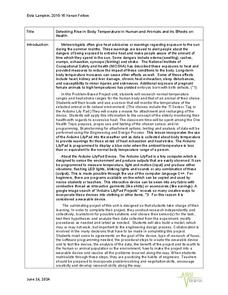University of Minnesota
Makes Me Sweat
Never let them see you sweat ... unless you can't help it! Scholars design an experiment to determine the effects of stress on the body. They monitor sweat production under different conditions and relate the response to the function of...
American Chemical Society
Keeping Warm in the Cold
Bundle up to stay warm! A fun-filled investigation opens with a group discussion about heat loss and using materials to prevent it. Young scientists then view an animation about thermometers and the Celsius scale and practice reading...
NOAA
Climate, Weather…What’s the Difference?: Make an Electronic Temperature Sensor
What's the best way to record temperature over a long period of time? Scholars learn about collection of weather and temperature data by building thermistors in the fourth installment of the 10-part Discover Your Changing World series....
Serendip
Should You Drink Sports Drinks? When? Why?
New research proves even rinsing your mouth with carbohydrates without swallowing improves performance of the central nervous system. While some think sports drinks are amazing, others say they are a waste of money. Scholars learn about...
Howard Hughes Medical Institute
How Did Dinosaurs Regulate Their Body Temperature?
Are dinosaurs more like birds or reptiles? Learners put the question to the test by analyzing body temperature data from a 2014 study. With their analysis, they develop a theory about the body temperature regulation of dinosaurs.
Kenan Fellows
Detecting Rise in Body Temperature in Human and Animals and its Effects on Health
Beat the heat using sensors. Scholars research normal body temperatures for humans and a specific animal. In groups, they create sensors that monitor body temperature, as well as the weather. The goal is to reduce the occurrence of heat...
Nuffield Foundation
Intrepreting Information about Sweating and Temperature
Why do we sweat? Scholars analyze data about body temperature, sweating, and other factors to better understand sweating. They note the changes after drinking ice water to sweating, skin temperature, and body temperature. Analysis...
CK-12 Foundation
Homeostasis
How much negative feedback does a body get daily? The interactive walks through one negative feedback loop, increasing body temperature. Then it challenges scholars to relate this to mechanical feedback loops and disorders that prevent...
PBL Pathways
Death Project
Verify the rule of thumb for finding the time of death. The project-based learning task asks pupils to determine when the rule of thumb process of finding the time of death is appropriate. Learners develop a function for the rule and...
National Park Service
Hibernation-Migration-Fascination
What's the difference between hibernation and a good nap? Find out with an engaging life science activity that compares the hibernation habits of grizzly bears and marmots. After learners read an informational passage about each mammal,...
Curated OER
Hibernation and Torpor
In this hibernation worksheet, students read about the differences between hibernation and torpor. Then students determine how long it takes for an animal to warm up or cool down its body. Students complete 4 short answer questions.
Curated OER
How Size Shapes Animals
Students investigate how size affects large and small animals differently. In this animal lesson plan, students determine how size affects different animals by constructing their own animal out of marshmallows. Once students create...
Curated OER
Fiber and Water
In this human body worksheet, students determine why the body needs water and how the body uses the water. Students understand the importance of fiber in their diet and how the body uses fiber. This worksheet has 14 short answer and 7...
Curated OER
Lactose Intolerance
Learners are taught how enzymes enable chemical reactions to occur a body temperature and how the lack of enzymes in the body can cause problems in the break-down and absorpion of nutrients. They match up different enzymes with the...
PBS
Pbs Learning Media: Body Breakdowns at High Altitudes
This interactive feature from the NOVA: "Surviving Denali" Web site details the variety of ways the body can fail while climbing a high-altitude peak.
Other
Simple Science: Taking Temperatures
The innovative resource investigates endothermy and ectothermy. Students compare body temperature of a snake and rat before and after exposure under a heat lamp. The activity has an interactive online version and a printable data sheet.
OpenStax
Open Stax: Anatomy and Physiology: Functions of the Integumentary System
Learn here all about how the integumentary system functions: such as protecting the body from invasion by microorganisms, chemicals, and other environmental factors; preventing dehydration; acting as a sensory organ; modulating body...
PBS
Pbs Learning Media: Fever!
This video describes the role of the brain in regulating body temperature and how sometimes fever is employed to fight off infection.
Georgia State University
Georgia State University: Hyper Physics: Temperature Regulation of the Human Body
Discusses the methods the human body uses to regulate body temperature. Includes links to the four external heat transfer mechanisms (radiation, conduction, convection, and evaporation of perspiration).
PBS
Pbs Teachers: Scientific American: Worried Sick: Temperature and Stress
Explore the physiological effects of stress, and investigate the techniques of Tibetan monks to regulate their body temperature. Attach a thermistor to your fingertip to see if relaxation techniques can produce changes in body temperature.
DOGO Media
Dogo News: Why Seeing Ice Powers Sends Shivers Down Your Spine
Article reports on the effect that seeing images of extreme cold can have on the physical body. Includes video.
Curated OER
Kids Health: A Kids Guide to Fever
Get the facts on what causes a fever and how you get rid of it in this article written for kids.
Other
Temperature of a Healthy Human (Body Temperature)
This site has several charts with explanations why your body temperature might not be 98.6 degrees fahrenheit.
Georgia State University
Georgia State University: Hyper Physics: Radiation Cooling of Body
Discusses the means by which the body regulates its temperature. The role of radiation in this process is explained. An equation for calculating the rate at which energy is transferred by radiation is presented. Also, an interactive...






















